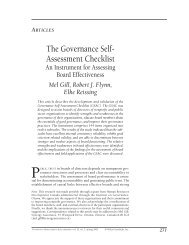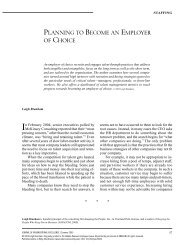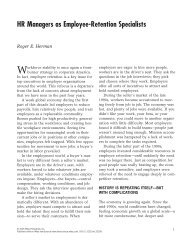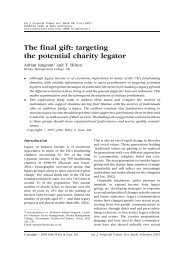RESEARCH ARTICLEor <strong>the</strong>ories. It means judging which rule is <strong>the</strong> mostappropriate in <strong>the</strong> concrete situation.Ano<strong>the</strong>r important consideration in <strong>the</strong> discussion<strong>of</strong> knowledge is <strong>the</strong> difference betweenespoused <strong><strong>the</strong>ory</strong> <strong>and</strong> <strong><strong>the</strong>ory</strong>-in-use. The way individualsact in <strong>the</strong> world depends <strong>of</strong> how <strong>the</strong>y interpret<strong>the</strong> world. The <strong><strong>the</strong>ory</strong> <strong>of</strong> action approachposits <strong>the</strong> existence <strong>of</strong> a behavioral world createdby <strong>the</strong> individuals in an interaction (Argyris <strong>and</strong>Schön, 1996, p. 50). These interpretations are againdependent on <strong>the</strong> way in which individuals are incontrol <strong>of</strong> generating, interpreting, testing <strong>and</strong>using data <strong>and</strong> information about <strong>the</strong> world. Theseactions <strong>of</strong> generating, interpreting, testing <strong>and</strong>using data <strong>and</strong> information will very <strong>of</strong>ten lead toa difference between what a person is saying <strong>and</strong>believes to be doing <strong>and</strong> <strong>the</strong> things that <strong>the</strong> personreally is doing. This is because <strong>the</strong> person, as a consequence<strong>of</strong> <strong>the</strong> testing discovers that he has toexplain or justify a given pattern <strong>of</strong> activity(Argyris <strong>and</strong> Schön, 1996, p. 13). However, <strong>the</strong> personin action does <strong>of</strong>ten not realize this differencebetween what is said <strong>and</strong> what is done. This meansthat a person can believe that in reality he is doingwhat he is saying. This lack <strong>of</strong> awareness is in away ‘designed’ in <strong>the</strong> head <strong>of</strong> that person to enablehim to justify <strong>the</strong> fact that on <strong>the</strong> one h<strong>and</strong> he doesthings differently from what he says he does.Fur<strong>the</strong>rmore it enables <strong>the</strong> person to deal with<strong>the</strong> fact that it is not acceptable to express <strong>the</strong> realnature <strong>of</strong> his actions in public.Argyris <strong>and</strong> Schön give an example <strong>of</strong> <strong>the</strong> differencesbetween espoused <strong><strong>the</strong>ory</strong> <strong>and</strong> <strong><strong>the</strong>ory</strong>-in-use<strong>and</strong> <strong>the</strong> (perceived) difficulties in revealing <strong>the</strong>sedifferences. The case describes a large electronicsfirm, where <strong>the</strong> Information Technology group,according to top management, did not react to <strong>the</strong>users’ needs <strong>and</strong> always had difficulties with linemanagement. The head <strong>of</strong> <strong>the</strong> IT group (<strong>the</strong> CIO)was interviewed about his thoughts <strong>and</strong> feelingsafter a staff meeting in which <strong>the</strong> problems werediscussed.When asked what led him not to make <strong>the</strong>sethoughts <strong>and</strong> feelings public, he looked astonished.‘If I said <strong>the</strong>se feelings <strong>and</strong> thoughts, all Ihave done was add fuel to <strong>the</strong> fire.’ ...whensome <strong>of</strong> <strong>the</strong> pr<strong>of</strong>essionals were asked if <strong>the</strong>y hadany idea <strong>of</strong> <strong>the</strong>ir bosses’ private thoughts, <strong>the</strong>yresponded with words that were almost identicalto <strong>the</strong> ones <strong>the</strong> CIO used. When <strong>the</strong>y were askedwhat led <strong>the</strong>m not to say so, <strong>the</strong>y responded with<strong>the</strong> same look <strong>of</strong> astonishment. ‘Are you kidding?’,said one <strong>of</strong> <strong>the</strong>m. ‘That would make thingsworse.’ Quite likely, <strong>the</strong> subordinates were alsocarrying on internal monologues that were notKnowledge <strong>and</strong> Process Managementvocalized. Thus we have people holding privateconversations about each o<strong>the</strong>r <strong>and</strong> thinking that<strong>the</strong> o<strong>the</strong>rs do not hear <strong>the</strong>se conversations. Inactuality, <strong>the</strong> o<strong>the</strong>rs do hear <strong>the</strong>m but act as if<strong>the</strong>y do not. (Argyris <strong>and</strong> Schön, 1996, p. 87f.).CHANGING THE PROCESSESOF LEARNINGNot being aware <strong>of</strong> this difference between what issaid <strong>and</strong> what is done will <strong>of</strong>ten present an obstacleto <strong>learning</strong>. But to be aware <strong>of</strong> this difference could,at least in some situations, mean that <strong>the</strong> individualshave to change <strong>the</strong> context or even, in radicalsituations, break out <strong>of</strong> <strong>the</strong> context <strong>and</strong> create awhole new context. This leads to three degrees <strong>of</strong><strong>learning</strong> situations:(1) Single-loop <strong>learning</strong>. Such instrumental <strong>learning</strong>consists <strong>of</strong> becoming better at doing what youcan already do. Thus <strong>the</strong> actions involved thatexist in this context must be <strong>of</strong> identifiabletypes.(2) Double-loop <strong>learning</strong>. This is <strong>learning</strong> that resultsin a change in <strong>the</strong> values <strong>of</strong> <strong>the</strong> <strong><strong>the</strong>ory</strong>-in-use,as well as in its strategies <strong>and</strong> assumptions(Argyris <strong>and</strong> Schön, 1996, p. 20f.). This meansthat <strong>the</strong> individual involved is aware <strong>and</strong> can<strong>the</strong>n take <strong>the</strong> context into consideration in <strong>the</strong><strong>learning</strong> process.(3) Triple-loop <strong>learning</strong>. In this situation is it impossibleto learn in <strong>the</strong> given context. Thus <strong>the</strong>individual involved has to break out <strong>of</strong>, <strong>and</strong>completely change, <strong>the</strong> context. This meanscreating or accepting new values in <strong>the</strong> <strong><strong>the</strong>ory</strong>in-useas well as new strategies in <strong>the</strong> <strong>learning</strong>process (Bateson, 1987, p. 287ff.).When a person has to go from double-loop <strong>learning</strong>to triple-loop <strong>learning</strong>, it is a consequence <strong>of</strong> adouble bind. On one side <strong>learning</strong> within <strong>the</strong> givencontext does not work because, even if <strong>the</strong> personchanges <strong>the</strong> values <strong>and</strong> strategies in <strong>the</strong> <strong><strong>the</strong>ory</strong>-inuse,this does not result in <strong>the</strong> expected consequences.On <strong>the</strong> o<strong>the</strong>r h<strong>and</strong>, <strong>the</strong> person sees <strong>the</strong>context as given <strong>and</strong> unchangeable. This meansthat ei<strong>the</strong>r <strong>the</strong> person breaks down or breaks out.The latter means that <strong>the</strong> person would resort totriple-loop <strong>learning</strong> <strong>and</strong>, in o<strong>the</strong>r words, createsan entirely new context.Represented in a diagram it looks as shown inFigures 1–3. Single-loop <strong>learning</strong> includes an adoption<strong>of</strong> ways to do things better (illustrated inFigure 1 by <strong>the</strong> single feedback loop). But existingnorms <strong>and</strong> routines are not changed. Double-loop56 P. E. Jensen
Knowledge <strong>and</strong> Process ManagementFigure 1Figure 2Figure 3Single-loop <strong>learning</strong>Double-loop <strong>learning</strong>Triple-loop <strong>learning</strong><strong>learning</strong> includes <strong>the</strong> kind <strong>of</strong> <strong>learning</strong> where norms<strong>and</strong> routines are changed, where <strong>the</strong> valuesguiding <strong>the</strong> existing context <strong>and</strong> strategies arequestioned <strong>and</strong> assumptions are under consideration(illustrated by <strong>the</strong> double feedback loop inFigure 2). In situations where double-loop <strong>learning</strong>takes place (going from single-loop <strong>learning</strong>) <strong>the</strong>reis an adoption <strong>of</strong> <strong>the</strong> results <strong>of</strong> <strong>the</strong> actions that stemsfrom <strong>the</strong> new activity, which can be calculatedahead <strong>and</strong> that, in fact, becomes <strong>the</strong> new activity.In situations where triple-loop <strong>learning</strong> takesplace an entirely new activity that cannot be precalculatedhas to be formulated <strong>and</strong> achieved. Itis, <strong>of</strong> course, a contradiction to do or to plan anactivity that is not known. Thus <strong>the</strong> new activityis achieved as a result <strong>of</strong> <strong>the</strong> contradictionsbetween <strong>the</strong> activity, on <strong>the</strong> one h<strong>and</strong>, which couldbe calculated to be <strong>the</strong> answers to <strong>the</strong> newdem<strong>and</strong>s from <strong>the</strong> environments (double-loopfeedback) <strong>and</strong> a feasible new context selectedfrom among those which seem to be at h<strong>and</strong> <strong>and</strong>,on <strong>the</strong> o<strong>the</strong>r h<strong>and</strong>, <strong>the</strong> unknown <strong>and</strong> unpredictablefuture. This means that <strong>the</strong> context which, in fact,becomes <strong>the</strong> result <strong>of</strong> <strong>the</strong> ‘breaking out’ will be differentfrom <strong>the</strong> one predicted, because <strong>the</strong> newRESEARCH ARTICLEactivities lead to results o<strong>the</strong>r than those beingcalculated. This is so even though <strong>the</strong>se activitiesare available or are seen as a possibility from <strong>the</strong>vantage-point <strong>of</strong> <strong>the</strong> existing context. In this way<strong>the</strong>se activities exp<strong>and</strong>, transform <strong>and</strong> even break<strong>the</strong> frameworks <strong>of</strong> <strong>the</strong> calculated new context<strong>and</strong> develop into something even more distant<strong>and</strong> uncontrollable. That is why <strong>the</strong> new contextnever is, <strong>and</strong> never can be, qualitatively <strong>the</strong>same as planned in advance from <strong>the</strong> old context(Engeström, 1987, p. 184f.).These kinds <strong>of</strong> new activities are different from<strong>the</strong> adjustment <strong>of</strong> <strong>organization</strong>s by <strong>the</strong> changing<strong>of</strong> routines. They are <strong>the</strong> creation <strong>of</strong> new activitiesthat lead to new contexts. Changes in <strong>the</strong> formattingcontext represent a parallel to double-loop<strong>learning</strong>. Double-loop <strong>learning</strong> is a process thatquestions <strong>the</strong> formatting context that, in turn, givesmeaning to <strong>the</strong> routines guiding single-loop <strong>learning</strong>.So if double-loop <strong>learning</strong> in itself is a routine(as Nelson <strong>and</strong> Winter (1982, p. 16f.) regard it tobe), it has to be <strong>of</strong> a different kind than those routinesguiding single-loop <strong>learning</strong>. And even so, itwill be impossible to treat triple-loop <strong>learning</strong> asroutine, because triple-loop <strong>learning</strong> cannot be calculatedin advance, <strong>and</strong> thus is not consistentenough or predictable enough to become a routine(Ciborra <strong>and</strong> Schneider, 1992, p. 273). Triple-loop<strong>learning</strong> is not something that happens automaticallyleading to new, more appropriate behaviour.On <strong>the</strong> contrary, resistance towards changes canlead to ignoring facts or <strong>the</strong> suppression <strong>of</strong> events,abnormalities <strong>and</strong> disturbances under <strong>the</strong> name <strong>of</strong>‘leadership’ (Ciborra <strong>and</strong> Schneider, 1992, p. 272).Triple-loop <strong>learning</strong> also involves recognizing <strong>the</strong>difference between espoused <strong>the</strong>ories <strong>and</strong> <strong><strong>the</strong>ory</strong>in-use,which is <strong>of</strong>ten a painful process.Let us see how such <strong>learning</strong> processes can beillustrated. In <strong>the</strong> example above where a studentin economics had to answer a question in descriptiveeconomics about employment/unemployment,a student who is well trained in <strong>the</strong>application <strong>of</strong> descriptive statistics will have littledifficulty in finding <strong>the</strong> appropriate statisticssources <strong>and</strong> extracting <strong>the</strong> appropriate data from<strong>the</strong>m. The more <strong>the</strong> student uses <strong>the</strong>se kinds <strong>of</strong>statistics, <strong>the</strong> better (<strong>and</strong> faster) he will be at collecting<strong>the</strong> appropriate data. Single-loop <strong>learning</strong> hasoccurred, i.e. <strong>the</strong> student uses his ‘action programme’(see Figure 1), which in this situation‘tells’ him what kind <strong>of</strong> descriptive statistics hecan use in order to fulfil <strong>the</strong> ‘production process’,i.e. to answer <strong>the</strong> question by giving an appropriateestimate over a period in which both employment<strong>and</strong> unemployment have grown for <strong>the</strong> samepopulation.A Contextual Theory <strong>of</strong> Learning 57







